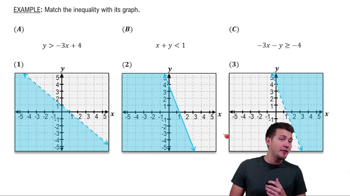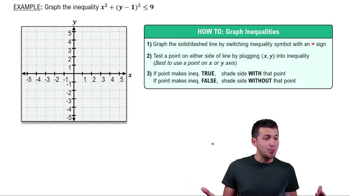Table of contents
- 0. Review of Algebra4h 16m
- 1. Equations & Inequalities3h 18m
- 2. Graphs of Equations43m
- 3. Functions2h 17m
- 4. Polynomial Functions1h 44m
- 5. Rational Functions1h 23m
- 6. Exponential & Logarithmic Functions2h 28m
- 7. Systems of Equations & Matrices4h 6m
- 8. Conic Sections2h 23m
- 9. Sequences, Series, & Induction1h 19m
- 10. Combinatorics & Probability1h 45m
7. Systems of Equations & Matrices
Graphing Systems of Inequalities
Problem 57b
Textbook Question
In Exercises 27–62, graph the solution set of each system of inequalities or indicate that the system has no solution. x−y≤2, x>−2, y≤3
 Verified step by step guidance
Verified step by step guidance1
Step 1: Graph the inequality x - y \leq -3. To do this, first rewrite it in slope-intercept form: y \geq x + 3. This is a line with a slope of 1 and a y-intercept of 3. Shade the region above this line.
Step 2: Graph the inequality x > -5. This is a vertical line at x = -5. Shade the region to the right of this line.
Step 3: Graph the inequality y \leq 1. This is a horizontal line at y = 1. Shade the region below this line.
Step 4: Identify the region where all shaded areas overlap. This is the solution set for the system of inequalities.
Step 5: Verify the solution by checking if a point within the overlapping region satisfies all the inequalities.
Recommended similar problem, with video answer:
 Verified Solution
Verified SolutionThis video solution was recommended by our tutors as helpful for the problem above
Video duration:
7mPlay a video:
Was this helpful?
Key Concepts
Here are the essential concepts you must grasp in order to answer the question correctly.
Inequalities
Inequalities are mathematical expressions that show the relationship between two values when they are not equal. They can be represented using symbols such as ≤ (less than or equal to), ≥ (greater than or equal to), < (less than), and > (greater than). Understanding how to interpret and manipulate inequalities is crucial for solving systems of inequalities.
Recommended video:

Linear Inequalities
Graphing Linear Inequalities
Graphing linear inequalities involves representing the solutions of an inequality on a coordinate plane. The boundary line is drawn based on the corresponding equation, and the region that satisfies the inequality is shaded. For example, a 'less than' inequality will shade below the line, while a 'greater than' inequality will shade above it, indicating the solution set.
Recommended video:

Linear Inequalities
Systems of Inequalities
A system of inequalities consists of two or more inequalities that are considered simultaneously. The solution to the system is the region where the shaded areas of all inequalities overlap on the graph. Analyzing systems of inequalities is essential for determining feasible solutions in various applications, such as optimization problems.
Recommended video:
Guided course

Systems of Inequalities

 7:2m
7:2mWatch next
Master Linear Inequalities with a bite sized video explanation from Patrick Ford
Start learning




